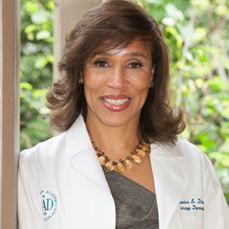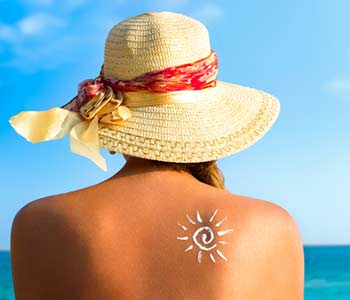SKIN CANCER SURGERY AT image Dermatology ® P.C., MONTCLAIR, NJ
Skin care is a critical aspect of Dr. Downie’s Montclair dermatological practice. She is a fellow of the Skin Cancer Foundation, and can be found on various media outlets educating the public about skin cancer, self-checks, and the need for sun block and skin protection. She is featured on The Today Show repeatedly as well as Dr. Oz and Good Morning America discussing skin cancer, sunscreen and she discussed ways to stay safe in the sun.
SKIN CANCER A REAL PROBLEM IN OUR COUNTRY
Every year, approximately 3.7 million Americans are diagnosed with skin cancer. That figure is on the rise and Dr. Downie believes it will continue to increase as thousands of young women and men choose to subject themselves to the hazards of tanning beds. Additionally less than 30 percent of Americans wear sun block on a regular basis. Skin cancer is serious, and is the most common form of cancer in the United States. People need to be aware of their skin and notice if a mole is changing; if a bump or nodule appears or is not healing properly.
Total body checks are extremely important in catching skin cancer in its early stages, before other organs are involved. Everyone needs a total skin surface check at least once a year by a board certified dermatologist. If you have a history of skin cancer, you must come in more frequently for a total body check. Dr. Downie offers total body skin checks, from scalp to toes, and spends time educating her patients about the importance of wearing sun block and taking good care of their skin.
Montclair Dermatologist Dr. Jeanine Downie discusses Skin Cancer

Hi, everyone. My name is Dr. Jeanine Downie and I’m a board-certified dermatologist. I am the director and president of image Dermatology ® P.C. in Montclair, New Jersey. Today, I’m going to talk to you guys about skin cancer, something that I’m passionate about decreasing the incidences of in this country and, quite frankly, around the world.
Unfortunately, there are over 4.2 million new cases of skin cancer that were diagnosed last year alone. That number is expected to increase and then increase again and continue to increase. This is because of our increased leisure time and the fact that people do not put on sunblock and if they do they do not reapply it like they should.
Unfortunately, anybody with skin is at risk of skin cancer. That’s why it’s called skin cancer. The bottom line is you see more Caucasian males over the age of 50 than anyone else with skin cancer but the bottom line here is that pretty much after the age of 65 one in five Americans will get skin cancer. Many of these people are brown, they are not all Caucasian, so the thought that sunblock should only be worn by lighter races is a flawed construct and is not reality.
So who is most at risk for skin cancers? Like I started to say before, you see it a lot with Caucasian males over the age of 50 but you can see skin cancer in anyone and everyone. We see a lot of them in people that use tanning beds. That means there is a great increase in skin cancer in white females between the ages of 25 and 29. Many of them have melanomas. When you use a tanning bed, tanning beds are 12 to 15 times the Ultraviolet radiation of the sun so you’re increasing your chances of getting skin cancer by over 70 percent by using tanning beds. So I tell people not to use tanning beds, there is no such thing as a safe tan, and there is no such thing as getting a base tan so that you tan better.
Other people that are at risk for skin cancers are people that have a family history of skin cancers or that have a personal history of skin cancers. If you have either one of those two things, you need to be checked more frequently. If you have a ton of moles all over your body, you need to be checked more frequently and are at a higher risk for skin cancer. If you’ve got red hair – I’ve got my brown hair – you need to be checked more for skin cancer. So if you’re light skinned, that is, if you’re Caucasian if you’re Asian-American, if you’re a light-skinned Latino- American or light-skinned African-American, those people are also at risk for skin cancer and, in addition, people that have a history of severe blistering sunburns are absolutely at risk for skin cancer. That’s significant as well. So all of these things coupled together with the fact that people aren’t wearing sunscreen like they should and are not reapplying it, that’s what makes this a crisis situation with over 4.2 million new cases each year and getting worse and worse.
One of the most unfortunate stories that is well-known at this point is Bob Marley, the reggae legend, died of a malignant melanoma. So how this occurred, he had a streak underneath his toenail that was a junctional nevi, in other words, a benign mole, and it changed over time and it became a malignant melanoma. African-Americans and some other ethnic minorities can have these streaks in their fingernails, which are called pigment streaks. If and when they get darker and they change, they can become a skin cancer. Unfortunately, Bob Marley was misdiagnosed. He played a lot of kickball or soccer or football they call it down in Jamaica, and they thought it was a soccer injury, they thought it was a bruise. So by the time that he was properly diagnosed, the melanoma had already metastasized. It spread to his brain, and then it went on and it killed him.
So this is just to tell you that even if you wear sunblock all the time, things like that, the doctors need to know that those are the two ethnic minorities, Asian-Americans and African-Americans, where you can see ALM’s – that is, Acral Lentiginous Melanoma – underneath the toenail and underneath the fingernail. So doctors need to be made more aware of this, and Bob Marley died at 38. And he deprived us of a lot of good music as far as I’m concerned. He’s still one of my favorites today.
If you lived once in an area that was close by the Equator — Florida, the Caribbean, Mexico, South America, all over Africa, parts of Indonesia, Australia — the bottom line is you are more predisposed to getting skin cancer because of the amount of Ultraviolet light during the day every day that you took in. The time hours that one needs to avoid are mainly the hours between 10:00 in the morning and 2:00 in the afternoon. Those are the hours where you can get the maximum amount of burn. Of course, you can burn at 8 a.m. and, of course, you can burn at 5 p.m. but sun avoidance during those hours is critical. And if you are out and about, it’s important to put sunblock on, reapply it, wear sun-protective clothing, wear a sun-protective hat and wear sun-protective sunglasses. So that’s all very, very critical and those are things that I want people to think about when they’re thinking about when they should avoid exposure to the sun. That’s important.
Sunscreen, so this is one of my favorite topics. My patients call me the ‘sunscreen or sunblock police.’ First of all, understand that there is no true sunblock. Nothing is blocking totally from the sun unless it’s night-time. So people need to wear an SPF 30 every single day, rain or shine, January through December, regardless of your ethnicity. An SPF of 15 gives you about 93.5 protection from the sun’s rays. An SPF of 30 gives you about 96.7 percent protection from the sun’s rays. When you go above a 30, it levels out around a 45 so maybe it’s 97 percent. But even if you use an SPF of 100, it’s never 100 percent protection from the sun’s rays. So the bottom line is, if you live closer to the Equator, you need to reapply it properly every hour. If you live farther away from the Equator, you need to reapply it every two hours.
At a minimum, sunscreen should be reapplied every two hours while you are out in the sun and while you’re doing your daily activities, even if you are sitting by a sunny window. UVA rays penetrate through the glass or through your car when you’re driving and UVB rays are deflecting, so you still need sunblock on in the car and you need it on in dreary and rainy weather, because 77 percent of the sun’s rays penetrate through the clouds on a cloudy day. So you need to put it on. You need to reapply it, and I don’t want people to get fooled by an SPF of 70 or 100. Bottom line is those are helpful, but they still need to be diligently applied and reapplied. And people should use about a shot glass-full all over their face, their neck, their ears, an the backs of their hands, which are the most critical and the most over-exposed areas and this is where we as doctors find the majority of the skin cancers that we detect.
The importance of self-exams with skin cancers is obvious. The bottom line is that so many of my patients come in here on an almost daily basis. And they say to me, ‘Hey, Dr. Downie, that mole is changing.’ And I say to them, ‘OK.’ And we talk about it and many times I biopsy it. They help me save their lives. So if you see a mole that’s changing, that’s important to bring it to the attention of their board-certified dermatologist. So once a month I ask my patients just pick a day of the month. Typically, I say if you’re born on the 27th of the month like I was for October, I pick that day and I go through my skin head-to-toe and I make sure that I have no abnormal moles. I look at my back. I look everywhere. If there’s something I see that’s different, I’ll show it to my husband and ask him if he think it’s different. So it’s important that you look at yourself once a month and make sure no moles are changing. Now, another thing you need to worry about is if you have a lump or a bump or a patch that’s not healing. That could also be a skin cancer.
So in terms of warning signs – what do you look for in moles specifically? Asymmetry – there is the ABCDs of melanoma. ‘A’ is Asymmetry. So if you have a mole on yourself that can’t fold back on itself, so it’s jagged and it’s asymmetrical. That is a mole that could be a problem, that could be changing. Bring it to the attention of your board-certified dermatologist. If you have a mole that’s irregular, that looks like a jigsaw puzzle, that means the borders are irregular. Again, bring it to the attention of your board-certified dermatologist. There was a gentleman that came in here the summer before last that had pink, blue, light-brown, and red, and black all in his melanoma it turned out to be. The minute I saw his large patch of mole on his back, my heart fell and my stomach clenched, because I knew before I even did a biopsy. So if you have unusual colors in a mole, please, for the sake of yourself and your loved ones, bring it to our attention. So that’s color. So that’s Asymmetry, Borders, and Colors and then ‘D’ is ‘diameter.’ If it’s bigger than the size of a pencil eraser, again, it could be a problem. However, there are many basal cells, squamous cells, and melanomas that are tiny, that are pinpoint, that are still an issue.
So if you have a mole that’s changing, that’s causing you pain, that’s swelling, that’s bleeding. If you think something is a pimple and it’s not healing. All pimples heal. Just please bring it to our attention, so we can either reassure you or we can biopsy it. Those are the two choices. And then we can take it from there. But educated we stand when we’re together. As a board-certified dermatologist, myself and my colleagues are here to educate people on skin cancer and to help people in terms of what their decisions are with their overall skin health. Cancer on the skin can be seen, so it can be detected. So if you can help us help you decrease the incidence of skin cancer by listening to my tips, I would so appreciate it. And so will your loved ones and your family. Thank you so much.
SKIN CANCER SURGERY AN EXCELLENT SOLUTION
Dr. Downie provides very precise dermatologic care to patients from Montclair and surrounding areas. If a suspicious lesion is detected, a biopsy is taken and sent to the pathology lab. The biopsy procedure is a quick and simple taking of a skin sample. We numb the patient with a needle, take a skin sample and either suture or stop the bleeding with a chemical. If the pathology report identifies cancerous cells in the sample, an excision procedure will be scheduled to remove the mole or growth.
The excision of a cancerous lesion takes place in our office after the area has been numbed with local anesthetic. Excisions are comfortable for the patient. Incisions are made around the mole or growth based on the visualization of its borders, and Dr. Downie moves inward to ensure the entirety of the growth is removed. After removal, incisions are closed with sutures and a dressing may be applied.
Recovering from the excision of a cancerous mole or growth may be different for each patient. The extent of recovery is largely based on the size and area of the growth. During your appointment with Dr. Downie, she will discuss the steps that can be taken to facilitate a comfortable, uncomplicated healing process. Dr. Downie recommends cleaning the area with peroxide and keeping it covered with Bionect or Biafine (2 prescription antibacterials) and a bandaid.
UNDERSTANDING RISKS
The risks associated with excision of skin cancer include pain, bleeding, or infection of the wound and scarring. It is also possible that, if a skin graft is placed, the graft will not heal appropriately. Lastly, excision may not completely remove all cancer cells. Your dermatologist has extensive training and experience treating the various types of skin cancer. Using a great deal of precision, Dr. Downie strives to achieve the best outcome in a single treatment.
COMMON QUESTIONS
The most common types of skin cancer are associated with sun exposure. Therefore, common places for non-melanoma skin cancers include the scalp, ears, nose, lips, face, shoulders, arms, and hands. Melanoma skin cancer can occur anywhere on the body, including areas not regularly exposed to UV rays. Unusual places for melanoma to show up include the palms of the hands, soles of the feetand in the genitalia.
While there is no guarantee that any skin cancer removal is 100 percent effective, most people do not experience the recurrence of skin cancer in the same growth. It is important, however, to remain vigilant about sun protection and skin examinations after a skin cancer has been treated. The American Academy of Dermatology reports that those who have developed one skin cancer are more likely to develop more in the future.
Skin cancer is a problem of increasing proportions in our country. However, the power to prevent skin cancer lies in each individual. Dr. Downie discusses skin cancer at length with her patients and advises them on the best protocol for sun protection. The daily application and reapplication of a broad-spectrum sunscreen with at least anspf of 30 and above is a key component to skin health. Dr. Downie also teaches patients how to perform monthly self-examinations so that suspicious lesions are quickly identified. Professional skin examinations should be scheduled in our office at least yearly. Patients who have been treated for skin cancer should return every six months or sooner.
If you have noticed moles or skin tags that have changed in size, shape, or color, that itch or are painful and want to have a complete body check to diagnose possible problems, call Dr. Downie’s Montclair dermatology office today. Put your skin in her capable hands when you schedule a skin cancer screening.
RELATED VIDEOS
Removal of Skin Tags With Liquid Nitrogen

Hey Instagram fans, happy Friday! Here with one of my favorite patients that does not want to be identified. We are going to do some liquid nitrogen on him to help to decrease and remove cancerous lesions so he has a couple of areas that have suffered sun damage over the years and we are going to take off a couple of skin tags including where I have missed form the last time he was here – which apparently he said is the only one that I had not taken off. I am going to take it off and we are doing it on a Friday morning so please watch and do enjoy!
Watch how skin tags are removed

Hey Instagram fans, happy Friday, good afternoon, I’m here with one of my patients taking off an eyelid skin tag. Patients hate them. They grow in males, females, black, white, Lati-no and Asian patients. Everybody can’t stand them, and somebody, that would be my patient, has a big birthday coming up and wants to look her best, so it has to go because by the time her birthday comes around it’s only going to be bigger. So, a couple of facts about skin tags: Every-thing that people think are skin tags, are not skin tags. So if you think you have a skin tag, get it checked out by a board-certified dermatologist, make sure it actually is only benign. That’s one. Two, they’re really easily removed by a board-certified dermatologist or plastic surgeon. We numb you, we remove it—in this case I’m going to clip it off—we put something on to stop the bleeding, and then it’s her eyelid, I can’t give her a regular bandaid because she’ll blink that off, so we do liquid bandaid with tons of sunblock for proper healing. So that’s pretty much the pro-cedure, it’s really easy, but me, Jeanine Downie, here on a Friday, I’m here to tell you, I want to rid the world of skin tags. So we’re gonna do it one by one, so please watch and enjoy.




















